12.1: The Powers of the Presidency
12.1.1: Expressed Powers
The expressed powers of the President are those expressed in the Constitution of the United States.
Learning Objective
Discuss the expressed powers of the President in the Constitution of the United States
Key Points
- Article Two of the United States Constitution creates the executive branch of the government, consisting of the President, the Vice President, and other executive officers chosen by the President.
- Perhaps the most important of all presidential powers is command of the United States Armed Forces as commander-in-chief. While the power to declare war is constitutionally vested in Congress, the president commands and directs the military and is responsible for planning military strategy.
- Along with the armed forces, the president also directs U.S. foreign policy. Through the Department of State and the Department of Defense, the president is responsible for the protection of Americans abroad and of foreign nationals in the United States.
- The president decides whether to recognize new nations and new governments, and negotiates treaties with other nations, which become binding on the United States when approved by two-thirds vote of the Senate.
- The president also has the power to nominate federal judges, including members of the United States courts of appeals and the Supreme Court of the United States.
- The Constitution’s Ineligibility Clause prevents the President from simultaneously being a member of Congress. Therefore, the president cannot directly introduce legislative proposals for consideration in Congress.
Key Terms
- senatorial courtesy
-
an unwritten political custom (or constitutional convention) in the United States whereby the president consults the senior U.S. Senator of his political party of a given state before nominating any person to a federal vacancy within that Senator’s state
- war powers resolution
-
The War Powers Resolution of 1973 (50 U.S.C. 1541-1548)[1] is a federal law intended to check the President’s power to commit the United States to an armed conflict without the consent of Congress. The resolution was adopted in the form of a United States Congress joint resolution; this provides that the President can send U.S. armed forces into action abroad only by authorization of Congress or in case of “a national emergency created by attack upon the United States, its territories or possessions, or its armed forces. “
- twenty-third amendment
-
Under the Twenty-third Amendment, the District of Columbia may choose no more electors than the state with the lowest number of electoral votes. No Senators, Representatives or federal officers may become Electors.
- ineligibility clause
-
The Constitution’s Ineligibility Clause prevents the president from simultaneously being a member of Congress. Therefore, the president cannot directly introduce legislative proposals for consideration in Congress.
Example
- While historically presidents initiated the process for going to war, critics have charged that there have been several conflicts in which presidents did not get official declarations, including Theodore Roosevelt’s military move into Panama in 1903, the Korean War, the Vietnam War, the invasions of Grenada in 1983 and Panama in 1990.
The expressed powers of the President are those expressed in the Constitution of the United States.
President and Vice President
Article Two of the United States Constitution creates the executive branch of the government, consisting of the president, the vice president, and other executive officers chosen by the president. Clause 1 states that “the executive Power shall be vested in a President of the United States of America. He shall hold his Office during the Term of four Years, and, together with the Vice President, chosen for the same Term, be elected, as follows. ” Clause one is a “vesting clause,” similar to other clauses in Articles 1 and 3, but it vests the power to execute the instructions of Congress, which has the exclusive power to make laws.
Clause 2 states the method for choosing electors in the Electoral College. Under the U.S. Constitution the president and vice president are chosen by electors, under a constitutional grant of authority delegated to the legislatures of the states and the District of Columbia. In other words, the constitution lets the state legislatures decide how electors are created. It does not define or delimit what process a state legislature may use to create its state’s college of electors. In practice, since the 1820s, state legislatures have generally chosen to create electors through an indirect popular vote. Each state chooses as many electors as it has Representatives and Senators in Congress. Under the Twenty-third Amendment, the District of Columbia may choose no more electors than the state with the lowest number of electoral votes. Senators, Representatives, or federal officers may not become electors.
Presidential Powers
Perhaps the most important of all presidential powers is commander-in-chief of the United States Armed Forces. While the power to declare war is constitutionally vested in Congress, the president commands and directs the military and is responsible for planning military strategy. Congress, pursuant to the War Powers Resolution, must authorize any troop deployments longer than 60 days, although that process relies on triggering mechanisms that never have been employed, rendering it ineffectual. Additionally, Congress provides a check on presidential military power through its control over military spending and regulation. While historically presidents initiated the process for going to war, critics have charged that there have been several conflicts in which presidents did not get official declarations, including Theodore Roosevelt’s military move into Panama in 1903, the Korean War, the Vietnam War, and the invasions of Grenada in 1983 and Panama in 1990. The “wars” waged in Iran (2001) and Afghanistan since (2003) are officially called “military engagements” authorized by Congress. Officially, the U.S. was not at war with the governments of those nations, but fought non-government terrorist groups.
Along with the armed forces, the president also directs U.S. foreign policy . Through the Department of State and the Department of Defense, the president is responsible for the protection of Americans abroad and of foreign nationals in the United States. The president decides whether to recognize new nations and new governments, and negotiates treaties with other nations, which become binding on the United States when approved by a two-thirds vote of the Senate .
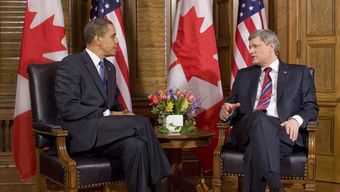
President Barack Obama meets Prime Minister Stephen Harper
Barack Obama, President of the United States of America, with Stephen Harper, Prime Minister of Canada.
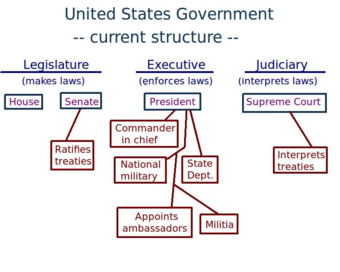
U.S. Foreign Policy Structure
The task of making foreign policy in the United States, according to the United States Constitution, is divided among different branches of government, with the executive branch having much of the decision-making authority, while the Senate ratifies treaties (2/3 vote needed to pass) and the Supreme Court rules on how to interpret treaties. Congress has a role in controlling appropriations for military expenditures.
The president is the head of the executive branch of the federal government and is constitutionally obligated to “take care that the laws be faithfully executed. ” Generally, a president may remove purely executive officials at his discretion. However, Congress can curtail and constrain a president’s authority to fire commissioners of independent regulatory agencies and certain inferior executive officers by statute. To manage the growing federal bureaucracy, presidents have gradually surrounded themselves with many layers of staff who were eventually organized into the Executive Office of the President of the United States.
The president also has the power to nominate federal judges, including members of the United States courts of appeals and the Supreme Court of the United States. However, these nominations require Senate confirmation. Securing Senate approval can provide a major obstacle for presidents who wish to orient the federal judiciary toward a particular ideological stance. When nominating judges to U.S. district courts, presidents often respect the long-standing tradition of Senatorial courtesy.
The Constitution’s Ineligibility Clause prevents the president from simultaneously being a member of Congress. Therefore, the president cannot directly introduce legislative proposals for consideration in Congress. However, the president can take an indirect role in shaping legislation, especially if the president’s political party has a majority in one or both houses of Congress. For example, the president or other officials of the executive branch may draft legislation and then ask senators or representatives to introduce these drafts into Congress. The president can further influence the legislative branch through constitutionally mandated, periodic reports to Congress. These reports may be either written or oral, but today are given as the State of the Union address, which often outlines the president’s legislative proposals for the coming year.
12.1.2: Delegated Powers
The delegated powers are a list of items found in the U.S. Constitution that set forth the authoritative capacity of Congress.
Learning Objective
Compare and contrast the “strict constructionists” and “loose constructionists” schools of thought of the Constitution
Key Points
- Many presidential powers are delegated powers that Congress has accorded presidents to exercise on its behalf, and that it can cut back or rescind.
- The delegated powers are a list of items found in Article I, Section 8 of the U.S. Constitution that set forth the authoritative capacity of Congress. In summary, Congress may exercise the powers that the Constitution grants it.
- Strict constructionism refers to a particular legal philosophy of judicial interpretation that limits or restricts judicial interpretation. The phrase is also commonly used more loosely as a generic term for conservatism among the judiciary.
- Loose constructionists provide a wider and broader reading of the Constitution and amendments passed historically.
- The Enumerated Powers Act is a proposed law that would require all bills introduced in the U.S. Congress to include a statement setting forth the specific constitutional authority under which each bill is being enacted.
Key Terms
- Enumerated Powers Act
-
a proposed bill in the United States House of Representatives which requires legislation passed by Congress cite those provisions of the Constitution that give them the power to pass such legislation. The bill has been proposed by Congressman John Shadegg in every Congress since the 104th, and frequently draws many co-sponsors. It has never been passed. However, at the beginning of the 105th Congress, significant portions of the bill were adopted into House rule
- strict constructionism
-
a particular legal philosophy of judicial interpretation that limits or restricts judicial interpretation (the phrase is also commonly used more loosely as a generic term for conservatism among the judiciary)
- delegated powers
-
The delegated powers – also called enumerated powers – are a list of items found in Article I, Section 8 of the U.S. Constitution that set forth the authoritative capacity of Congress.
Introduction
Almost all presidential powers rely on what Congress does or does not do. Presidential executive orders implement the law, but Congress can overrule such orders by changing the law. And many presidential powers are delegated powers that Congress has accorded presidents to exercise on its behalf and that it can cut back or rescind.
Delegated Powers
The delegated powers, also called enumerated powers, are a list of items found in Article I, Section 8 of the U.S. Constitution that set forth the authoritative capacity of Congress. In summary, Congress may exercise the powers that the Constitution grants it, subject to explicit restrictions in the Bill of Rights and other protections in the Constitution. The Tenth Amendment states that “The powers not delegated to the United States by the Constitution, nor prohibited by it to the States, are reserved to the States respectively, or to the people. ” Historically, Congress and the Supreme Court of the United States have broadly interpreted these provisions.
The list of enumerated powers includes the following: “The Congress shall have Power To lay and collect Taxes, Duties, Imposts and Excises, to pay the Debts and provide for the common Defence and general Welfare of the United States; but all Duties, Imposts and Excises shall be uniform throughout the United States;” “To borrow Money on the credit of the United States;” “to declare War, grant Letters of Marque and Reprisal, and make Rules concerning Captures on Land and Water;” and “to make all Laws which shall be necessary and proper for carrying into Execution the foregoing Powers, and all other Powers vested by this Constitution in the Government of the United States, or in any Department or Officer thereof.”
Political Interpretation
There is a difference of opinion in the political arena on whether current interpretation of enumerated powers, as exercised by Congress, is constitutionally sound. One school of thought is called “strict constructionism.” Strict constructionists often reference a statement on the enumerated powers set forth by Chief Justice Marshall in the case McCulloch v. Maryland. Strict constructionism refers to a particular legal philosophy of judicial interpretation that limits or restricts judicial interpretation. The phrase is also commonly used more loosely as a generic term for conservatism among the judiciary.
Another school of thought is referred to as “loose constructionism.” Loose constructionists provide a wider and broader reading of the Constitution and amendments passed historically.
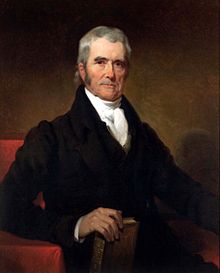
John Marshall
John Marshall’s writing about enumerated powers in McCullogh v. Maryland established constitutional proof for strict constructionists.
Interpretation of the Necessary and Proper Clause has been controversial, especially during the early years of the republic. Strict constructionists interpret the clause to mean that Congress may make a law only if the inability to do so would cripple its ability to apply one of its enumerated powers. Loose constructionists, on the other hand, interpret the Necessary and Proper Clause as expanding the authority of Congress to all areas tangentially related to one of its enumerated powers.
12.1.3: Inherent Powers
Inherent powers are assumed powers of the president not specifically listed in the Constitution.
Learning Objective
Discuss the source of the inherent powers of the President
Key Points
- The President derives these powers from the loosely worded statements in the Constitution that “the executive Power shall be vested in a President” and that he should “take care that the laws be faithfully executed”; defined through practice rather than through constitutional or statutory law.
- The first three presidents, Washington, Adams, and Jefferson established their importance concerning the inherent powers in different ways.
- Supporters of the unitary executive theory argue that this means that the president’s power, particularly the inherent power that come with being commander in chief, are open ended and cannot be checked by the other two branches.
Key Terms
- unitary executive theory
-
Supporters of the unitary executive theory argue that this means that the president’s power, particularly the inherent power that come with being commander in chief, are open-ended and cannot be checked by the other two branches.
- inherent powers
-
Inherent powers are assumed powers of the president not specifically listed in the Constitution. Inherent powers come from the president’s role as chief executive.
- unitary system
-
a state governed as one single unit in which the central government is supreme and any administrative divisions (subnational units) exercise only powers that their central government chooses to delegate
Inherent Powers
Inherent powers are those powers that a sovereign state holds. In the United States, the President derives these powers from the loosely worded statements in the Constitution that “the executive Power shall be vested in a President” and that the President should “take care that the laws be faithfully executed”; defined through practice rather than through constitutional or statutory law. In other words, Inherent powers are assumed powers of the president not specifically listed in the Constitution. Inherent powers come from the president’s role as chief executive.
The first three presidents, Washington, Adams, and Jefferson established their importance in different ways. First, Washington helped to establish them in the first place, when he wanted to use them as a basis for proclaiming a policy of strict neutrality when the British and French were at war. Then, due to Adams poor leadership skills, the Federalists and Anti-Federalists divisions were heightened and the development of political parties was quickened. Finally, Jefferson used the party system to cement strong ties with Congress and expanded the role of the president in the legislative process. He used the inherent powers to justify the Louisiana Purchase in 1803 which dramatically increased the size of our nation.
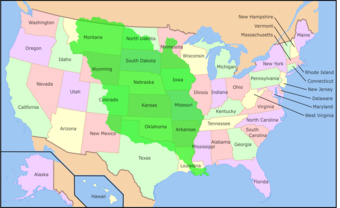
Louisiana Purchase
The Louisiana Purchase of 1803 increased the geographical size of the United States significantly.
The question of presidential power is complicated by a key omission in certain Constitutional sentences’ language. As opposed to Article 1, which states that Congress is vested with the legislative powers “herein granted,” Article 2 does not use that language. It says all executive power is vested in the president. Supporters of the unitary executive theory argue that this means that the president’s power, particularly the inherent power that come with being commander in chief, are open ended and cannot be checked by the other two branches.
12.1.4: Emergency Powers
The president of the United States, as head of the executive branch, has the authority to declare a federal state of emergency.
Learning Objective
Explain how states of emergency apply to the Executive Branch of the U.S. government
Key Points
- A state of emergency is a governmental declaration that may suspend some normal functions of the executive, legislative, and judicial powers; alert citizens to change their normal behaviors; or order government agencies to implement emergency preparedness plans.
- At least two constitutional rights are subject to revocation during a state of emergency: The right of habeas corpus, under Article 1, Section 9 and the right to a grand jury for members of the National Guard when in actual service, under the Fifth Amendment.
- The Insurrection Act of 1807 is the set of laws that govern the U.S. president’s ability to deploy troops within the United States to put down lawlessness, insurrection, and rebellion.
- The National Emergencies Act set a limit of two years on emergency declarations unless the president explicitly extends them, and requires the president to specify in advance which legal provisions will be invoked.
Key Terms
- insurrection act of 1807
-
The Insurrection Act of 1807 is the set of laws that govern the president’s ability to deploy troops within the United States to put down lawlessness, insurrection and rebellion.
- habeas corpus
-
A writ to bring a person before a court or a judge, most frequently used to ensure that a person’s imprisonment, detention, or commitment is legal.
- state of emergency
-
A government decree that a particular situation requires the implementation of pre-arranged responses on a large scale.
Example
- The United States has been in a state of national emergency continuously since September 14, 2001, when the Bush administration invoked it premised on the September 11 attacks. In September 2011, President Barack Obama informed Congress that the State of National Emergency, in effect since September 14, 2001, will be extended another year.
Introduction
A state of emergency is a governmental declaration that may suspend some normal functions of the executive, legislative, and judicial powers; alert citizens to change their normal behaviors; or order government agencies to implement emergency preparedness plans. It also can be used as a rationale for suspending rights and freedoms, even if guaranteed under the Constitution. Such declarations usually come during a time of natural or man-made disaster, periods of civil unrest, or following a declaration of war or situation of international or internal armed conflict.
Application in the United States
In the United States, there are several methods for government response to emergency situations. A state governor or local mayor may declare a state of emergency within his or her jurisdiction. This is common at the state level in response to natural disasters. The president of the United States, as head of the executive branch, has the authority to declare a federal state of emergency. At least two constitutional rights are subject to revocation during a state of emergency:
The right of habeas corpus, under Article 1, Section 9, and the right to a grand jury for members of the National Guard when in actual service, under Fifth Amendment.
Habeas corpus was suspended on April 27, 1861 during the American Civil War by Abraham Lincoln in parts of Maryland and some midwestern states, including southern Indiana. He did so in response to demands by generals to set up military courts to rein in “copperheads,” those in the Union who supported the Confederate cause. On December 16, 1950, during the Korean War, President Truman issued Presidential Proclamation No. 2914, declaring a state of national emergency. In 1952, the Supreme Court ruling in Youngstown Sheet & Tube Co. v. Sawyer established that presidents may not act contrary to Acts of Congress during an emergency.
The Insurrection Act of 1807is the set of laws that govern the president’s ability to deploy troops within the United States to put down lawlessness, insurrection, and rebellion. The general aim is to limit presidential power as much as possible, relying on state and local governments for initial response in the event of insurrection. Coupled with the Posse Comitatus Act, presidential powers for law enforcement are limited and delayed.
During the Watergate scandal, which erupted in the 1970s after President Richard Nixon authorized a variety of illegal acts, Congress investigated the extent of the president’s powers and belatedly realized that the United States had been in a continuous state of emergency since 1950. As a result, in 1976, the National Emergencies Act set a limit of two years on emergency declarations unless the president explicitly extends them and requires the president to specify in advance which legal provisions will be invoked. The act terminated the emergency of 1950 on September 14, 1978; however, even in the twenty-first century, the federal courts have upheld harsh penalties for crimes that occurred during the state of national emergency from 1950 to 1978, where the penalties were escalated because of the existence of that emergency.
Impact of the September 11 Attacks
The United States has been continuously in a state of national emergency since September 14, 2001, when the Bush administration invoked it premised on the September 11 attacks. In September 2011, President Barack Obama informed Congress that the State of National Emergency, in effect since September 14, 2001, would be extended another year. The National Emergencies Act grants various powers to the president during times of emergency and was intended to prevent a president from declaring a state of emergency of indefinite duration .
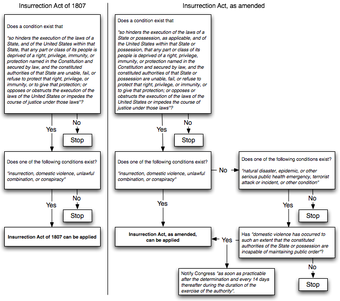
Insurrection Act of 1807 Flowchart
A flowchart comparison of when the provisions of the Insurrection Act can be implemented, under the original and amended wording.
On September 30, 2006, Congress modified the Insurrection Act, as part of the 2007 Defense Authorization Bill (repealed as of 2008). Section 1076 of the law changed Sec. 333 of the Insurrection Act of 1807 and widened the president’s ability to deploy troops within the United States to enforce the laws. Under this act, the president may also deploy troops as a police force during a natural disaster, epidemic, serious public health emergency, terrorist attack, or other condition, when the president determines that the authorities of the state are incapable of maintaining public order. The bill also modified Sec. 334 of this act, giving the president authority to order the dispersal of either insurgents or “those obstructing the enforcement of the laws. ” The law changed the name of the chapter from “Insurrection” to “Enforcement of the Laws to Restore Public Order. “
12.1.5: Executive Orders
In the United States, an executive order is an order or directive issued by the head of the executive branch at some level of government.
Learning Objective
Compare and contrast the different types of executive orders made by the President
Key Points
- The term executive order is most commonly applied to orders issued by the President, who is the head of the executive branch of the federal government. Executive orders may also be issued at the state level by a state’s governor or at the local level by the city’s mayor.
- Executive orders have the full force of law, since issuances are typically made in pursuance of certain Acts of Congress, some of which specifically delegate to the President some degree of discretionary power.
- Although there is no Constitutional provision or statute that explicitly permits executive orders, there is a vague grant of executive power given in Article II, Section 1, Clause 1 of the Constitution.
- A Presidential Determination is a document issued by the White House stating a determination resulting in an official policy or position of the executive branch of the United States government.
- Presidential memoranda do not have an established process for issuance or publication. Presidential memoranda are generally considered less prestigious than executive orders.
Key Terms
- executive agreement
-
an understanding, less formal than a treaty, between the United States (both the executive and legislative branch, or just the executive branch) and the government of a foreign state
- presidential memoranda
-
Presidential memoranda do not have an established process for issuance or publication. Presidential memoranda are generally considered less prestigious than executive orders. There are three types of memorandum: presidential determination or presidential finding, memorandum of disapproval, and hortatory memorandum.
- executive order
-
A legally enforceable order, decree, or regulation issued on the authority of the head of the executive branch of government.
- presidential determination
-
A Presidential Determination is a document issued by the White House stating a determination resulting in an official policy or position of the executive branch of the United States government.
Example
- One of the most famous presidential determinations was President Clinton’s Presidential Determination 95-45, which exempted the U.S. Air Force’s facility in the vicinity of Groom Lake, Nevada (commonly called Area 51) from environmental disclosure laws, in response to subpoenas from a lawsuit brought by Area 51 workers alleging illegal hazardous waste disposal which resulted in injury and death. Subsequent to this determination, the lawsuit was dismissed due to lack of evidence.
Introduction
In the United States, an executive order is an order or directive issued by the head of the executive branch at some level of government. The term executive order is most commonly applied to orders issued by the President, who is the head of the executive branch of the federal government. Executive orders may also be issued at the state level by a state’s governor or at the local level by the city’s mayor.
U.S. Presidents have issued executive orders since 1789, usually to help officers and agencies of the executive branch manage the operations within the federal government itself. Executive orders have the full force of law, since issuances are typically made in pursuance of certain Acts of Congress. Typically, these specifically delegate to the President a degree of discretionary power, or are believed to take authority from a power granted directly to the Executive by the Constitution. However, these perceived justifications cited by Presidents when authoring Executive Orders have come under criticism for exceeding Executive authority; at various times throughout U.S. history, challenges to the legal validity or justification for an order have resulted in legal proceedings.
Basis in U.S. Constitution
Although there is no Constitutional provision or statute that explicitly permits executive orders, there is a vague grant of executive power given in Article II, Section 1, Clause 1 of the Constitution, and furthered by the declaration “take Care that the Laws be faithfully executed” made in Article II, Section 3, Clause 5. Most executive orders use these Constitutional interpretations as the authorization allowing for their issuance to be justified as part of the President’s sworn duties. The intention is to help direct officers of the U.S. Executive carry out their delegated duties as well as the normal operations of the federal government: the consequence of failing to comply possibly being the removal from office.
Different Applications by President
A Presidential Determination is a document issued by the White House stating a determination resulting in an official policy or position of the executive branch of the United States government. Presidential determinations may involve any number of actions, including setting or changing foreign policy, setting drug enforcement policy, or any number of other exercises of executive power. One of the most famous presidential determinations was President Clinton’s Presidential Determination 95-45, which exempted the U.S. Air Force’s facility in the vicinity of Groom Lake, Nevada (commonly called Area 51) from environmental disclosure laws, in response to subpoenas from a lawsuit brought by Area 51 workers alleging illegal hazardous waste disposal which resulted in injury and death. Subsequent to this determination, the lawsuit was dismissed due to lack of evidence.
Similarly, presidential memoranda do not have an established process for issuance or publication. Presidential memoranda are generally considered less prestigious than executive orders. There are three types of memorandum: presidential determination or presidential finding, memorandum of disapproval, and hortatory memorandum.
Finally, a presidential proclamation “states a condition, declares a law and requires obedience, recognizes an event or triggers the implementation of a law (by recognizing that the circumstances in law have been realized). ” Presidents define situations or conditions on situations that become legal or an economic truth . These orders carry the same force of law as executive orders—the difference between the two is that executive orders are aimed at those inside government while proclamations are aimed at those outside government. The administrative weight of these proclamations is upheld because they are often specifically authorized by congressional statute, making them “delegated unilateral powers.” Presidential proclamations are often dismissed as a practical presidential tool for policymaking because of the perception of proclamations as largely ceremonial or symbolic in nature. However, the legal weight of presidential proclamations suggests their importance to presidential governance.
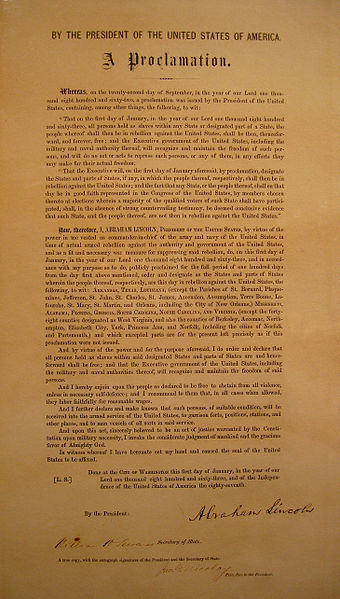
Emancipation Proclamation
Leland-Boker Authorized Edition of the Emancipation Proclamation, printed in June 1864 with a presidential signature
12.1.6: Executive Privilege
Executive privilege is the power claimed by the President to resist subpoenas and other interventions by other branches of government.
Learning Objective
Analyze the application of executive privilege by the President since World War II
Key Points
- The concept of executive privilege is not mentioned explicitly in the United States Constitution, but the Supreme Court of the United States ruled it to be an element of the separation of powers doctrine.
- The Supreme Court confirmed the legitimacy of this doctrine in United States v. Nixon, but only to the extent of confirming that there is a qualified privilege.
- The Clinton administration invoked executive privilege on fourteen occasions. In 1998, President Bill Clinton became the first President since Nixon to assert executive privilege and lose in court.
- On June 20, 2012, President Barack Obama asserted executive privilege, his first, to withhold certain Department of Justice documents related to the ongoing Operation Fast and Furious controversy.
Key Term
- executive privilege
-
In the United States government, executive privilege is the power claimed by the President of the United States and other members of the executive branch to resist certain subpoenas and other interventions by the legislative and judicial branches of government.
Introduction
In the United States government, executive privilege is the power claimed by the President of the United States and other members of the executive branch to resist certain subpoenas and other interventions by the legislative and judicial branches of government. The concept of executive privilege is not mentioned explicitly in the United States Constitution, but the Supreme Court of the United States ruled it to be an element of the separation of powers doctrine, and/or derived from the supremacy of the executive branch in its own area of Constitutional activity.
The Supreme Court confirmed the legitimacy of this doctrine in United States v. Nixon, but only to the extent of confirming that there is a qualified privilege. Once invoked, a presumption of privilege is established, requiring the prosecutor to make a “sufficient showing” that the “Presidential material” is “essential to the justice of the case. ” Historically, the uses of executive privilege underscore the untested nature of the doctrine, since Presidents have generally sidestepped open confrontations with the United States Congress and the courts over the issue by first asserting the privilege, then producing some of the documents requested on an assertedly voluntary basis.
Historical Development
During the period of 1947-49, several major security cases became known to Congress. There followed a series of investigations, culminating in the famous Hiss-Chambers case of 1948. At that point, the Truman Administration issued a sweeping secrecy order blocking congressional efforts from the FBI and other executive data on security problems. During the Army–McCarthy hearings in 1954, Eisenhower used the claim of executive privilege to forbid the “provision of any data about internal conversations, meetings, or written communication among staffers, with no exception to topics or people. ” Department of Defense employees were also instructed not to testify on any such conversations or produce any such documents or reproductions.
U.S. v. Nixon
The Supreme Court addressed “executive privilege” in United States v. Nixon, the 1974 case involving the demand by Watergate special prosecutor Archibald Cox that President Richard Nixon produce the audiotapes of conversations he and his colleagues had in the Oval Office of the White House in connection with criminal charges being brought against members of the Nixon Administration . Nixon invoked the privilege and refused to produce any records. Because Nixon had asserted only a generalized need for confidentiality, the Court held that the larger public interest in obtaining the truth in the context of a criminal prosecution took precedence.
Post-Nixon
The Clinton administration invoked executive privilege on fourteen occasions. In 1998, President Bill Clinton became the first President since Nixon to assert executive privilege and lose in court, when a federal judge ruled that Clinton aides could be called to testify in the Lewinsky scandal.
Correspondingly, the Bush administration invoked executive privilege on six occasions. President George W. Bush first asserted executive privilege to deny disclosure of sought details regarding former Attorney General Janet Reno, the scandal involving the Federal Bureau of Investigation (FBI) misuse of organized-crime informants James J. Bulger and Stephen Flemmi in Boston, and Justice Department deliberations about President Bill Clinton’s fundraising tactics, in December 2001. On August 1, 2007, Bush invoked the privilege for the fourth time in little over a month, this time rejecting a subpoena for Karl Rove. The subpoena would have required the President’s Senior Advisor to testify before the Senate Judiciary Committee in a probe over fired federal prosecutors.
On June 20, 2012, President Barack Obama asserted executive privilege, his first, to withhold certain Department of Justice documents related to the ongoing Operation Fast and Furious controversy ahead of a United States House Committee on Oversight and Government Reform vote to hold Attorney General Eric Holder in Contempt of Congress for refusing to produce the documents. Later the same day, the United States House Committee on Oversight and Government Reform voted 23-17 along party lines to hold Attorney General Holder in contempt of Congress over not releasing documents regarding Fast and Furious.
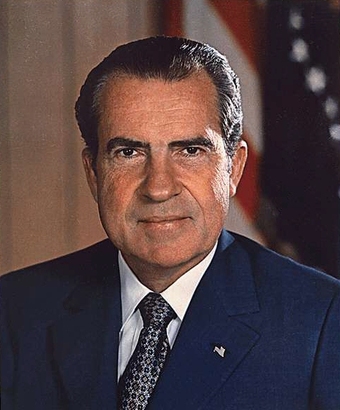
Richard Nixon, 37th President of the United States
Richard Milhous Nixon, 37th President of the United States.
12.1.7: The Expansion of Presidential Powers
Presidential power has shifted over time, which has resulted in claims that the modern presidency has become too powerful.
Learning Objective
Discuss how the powers and duties of the President have changed over time
Key Points
- The President of the United States of America is the head of state and head of government of the United States. The president leads the executive branch of the federal government and is the commander-in-chief of the United States Armed Forces.
- The president is the head of the executive branch of the federal government and is constitutionally obligated to “take care that the laws be faithfully executed. ” The executive branch has over four million employees, including members of the military.
- Perhaps the most important of all presidential powers is command of the United States Armed Forces as commander-in-chief. While the power to declare war is constitutionally vested in Congress, the president commands and directs the military and is responsible for planning military strategy.
Key Term
- executive privilege
-
In the United States government, executive privilege is the power claimed by the President of the United States and other members of the executive branch to resist certain subpoenas and other interventions by the legislative and judicial branches of government.
Chief Legislator
The President of the United States of America is the head of state and head of government of the United States. The president leads the executive branch of the federal government and is the commander-in-chief of the United States Armed Forces.
Powers and Duties
The first power the Constitution confers upon the president is the veto. The Presentment Clause requires any bill passed by Congress to be presented to the president before it can become law. Perhaps the most important of all presidential powers is command of the United States Armed Forces as commander-in-chief. While the power to declare war is constitutionally vested in Congress, the president commands and directs the military and is responsible for planning military strategy. Congress, pursuant to the War Powers Resolution, must authorize any troop deployments longer than 60 days, although that process relies on triggering mechanisms that have never been employed, rendering it ineffectual. Additionally, Congress provides a check to presidential military power through its control over military spending and regulation.
The president is the head of the executive branch of the federal government and is constitutionally obligated to “take care that the laws be faithfully executed. ” The executive branch has over four million employees, including members of the military. Presidents make numerous executive branch appointments–an incoming president may make up to 6,000 before he takes office and 8,000 more during his term. Ambassadors, members of the Cabinet, and other federal officers are all appointed by a president with the “advice and consent” of a majority of the Senate. Appointments made while the Senate is in recess are temporary and expire at the end of the next session of the Senate.
Historically, two doctrines concerning executive power have developed that enable the president to exercise executive power with a degree of autonomy. The first is executive privilege, which allows the president to withhold from disclosure any communications made directly to the president in the performance of executive duties. George Washington first claimed executive privilege when Congress requested to see Chief Justice John Jay’s notes from an unpopular treaty negotiation with Great Britain. While not enshrined in the Constitution, or any other law, Washington’s action created the precedent for the privilege. When Richard Nixon tried to use executive privilege as a reason for not turning over subpoenaed evidence to Congress during the Watergate scandal, the Supreme Court ruled in United States v. Nixon, 418 U.S. 683 (1974) that executive privilege did not apply in cases where a president was attempting to avoid criminal prosecution. When President Bill Clinton attempted to use executive privilege regarding the Lewinsky scandal, the Supreme Court ruled in Clinton v. Jones, 520 U.S. 681 (1997) that the privilege also could not be used in civil suits. These cases established the legal precedent that executive privilege is valid, although the exact extent of the privilege has yet to be clearly defined. Additionally, federal courts have allowed this privilege to radiate outward and protect other executive branch employees, but have weakened this protection for those executive branch communications that do not involve the president .
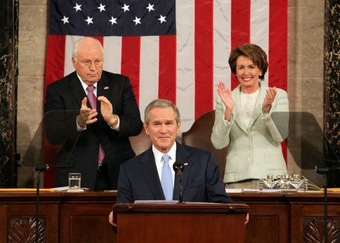
State of the Union 2007
A White House photo of President Bush, VP Cheney, and Speaker Pelosi at the 2007 State of the Union address. The photo has been cropped from the orginal to remove everything but the principals, the bottom stars on the flag, and the teleprompters. The caption given by the White House is: President George W. Bush receives applause while delivering the State of the Union address at the U.S. Capitol, Tuesday, January 23, 2007. Also pictured are Vice President Dick Cheney and Speaker of the House Nancy Pelosi. White House photo by David Bohrer.
Critics of Enhanced Presidency
Most of the nation’s Founding Fathers expected the Congress, which was the first branch of government described in the Constitution, to be the dominant branch of government. In other words, they did not expect a strong executive. However, presidential power has shifted over time, which has resulted in claims that the modern presidency has become too powerful, unchecked, unbalanced, and “monarchist” in nature. Critic Dana D. Nelson believes presidents over the past thirty years have worked towards “undivided presidential control of the executive branch and its agencies. ” She criticizes proponents of the unitary executive for expanding “the many existing uncheckable executive powers – such as executive orders, decrees, memorandums, proclamations, national security directives and legislative signing statements – that already allow presidents to enact a good deal of foreign and domestic policy without aid, interference or consent from Congress.” Other scholars disagree with the view that the presidency has too much power and cite the ability of Congress and the courts to block presidential actions. As an example, the Supreme Court in 2016 overturned Pres. Obama’s administrative appointment made during a Congressional recess, and is scheduled to rule on the constitutionality of an executive order know as DACA (Deferred Action for Childhood Arrivals) that delays deportation of undocumented residents who arrived as children.
12.2: The Organization and Institution of the Presidency
12.2.1: The Executive Office of the President
The Executive Office of the President is comprised of a Chief of Staff, Counsel, Press Secretary, and other members assisting the President of the United States.
Learning Objective
Distinguish the various key positions in the Executive Office and the roles and responsibilities of each
Key Points
- The White House Chief of Staff is the highest-ranking employee of the White House Office inside the Executive Office of the President of the United States and is an Assistant to the President.
- The roles of the Chief of Staff are both managerial and advisory and can include the following: select key White House staff and supervise them; structure the white house staff; control the flow of people into the Oval Office; and advice the President on various issues.
- The White House Counsel’s role is to advise the President on all legal issues concerning the President and the White House.
- The White House Press Secretary is responsible for collecting information about actions and events within the president’s administration and issues the administration’s reactions to developments around the world.
- The Chief of Staff is assisted by one or more Deputy Chiefs of Staff.
Key Terms
- white house chief of staff
-
The White House Chief of Staff is the highest-ranking employee of the White House Office inside the Executive Office of the President of the United States and is an Assistant to the President.
- de facto prime minister
-
It is possible that a powerful Chief of Staff with a “hands-off” president can become a de facto Prime Minister. Such prime ministers exist in some governmental systems: The prime minister runs the government, while the president remains somewhat aloof from the political process, but personally handling policy matters.
- white house press secretary
-
The White House Press Secretary is a senior White House official whose primary responsibility is to act as spokesperson for the government administration. The Press Secretary is responsible for collecting information about actions and events within the president’s administration and issues the administration’s reactions to developments around the world.
Example
- It is possible that a powerful Chief of Staff with a “hands-off” president can become a de facto Prime Minister. Such prime ministers exist in some governmental systems: The prime minister runs the government, while the president remains somewhat aloof from the political process, but personally handling policy matters. Richard Nixon’s first Chief of Staff, H.R. Haldeman, garnered a reputation in Washington for the iron hand he wielded in the position.
The Executive Office of the President (EOP) consists of the immediate staff of the President of the United States, as well as multiple levels of support staff reporting to the President. The EOP is headed by the White House Chief of Staff, currently Jacob Lew. The size of the White House staff has increased dramatically since 1939, and has grown to include an array of policy experts in various fields.
Chief of Staff
The White House Chief of Staff is an Assistant to the President, and is the highest-ranking employee of the White House Office inside the Executive Office of the President of the United States. The current White House Chief of Staff is Denis McDonough who took over the job from Jacob Lew in 2013.
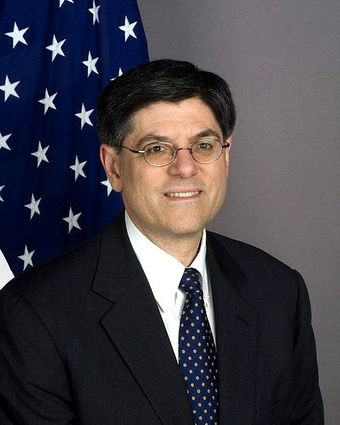
Jacob Lew
The current White House Chief of Staff is Jacob Lew, who assumed the position on January 27, 2012, after William M. Daley resigned.
The duties of the White House Chief of Staff vary greatly from one administration to another; in fact, there is no legal requirement that the President even fill the position. However, since at least 1979, all Presidents have found the need for a Chief of Staff, who typically oversees the actions of the White House staff, manages the president’s schedule, and decides who is allowed to meet with the president. Because of these duties, the Chief of Staff has at various times been labeled “The Gatekeeper,” “The Power Behind the Throne,” and “The Co-President. “
The roles of the Chief of Staff are both managerial and advisory. the Chief of Staff may select key White House staff and supervise them; structure the White House staff; control the flow of people into the Oval Office; and advise the President on various issues.
A powerful Chief of Staff with a “hands-off” president can become a de facto Prime Minister. Such prime ministers exist in some governmental systems: The prime minister runs the government, while the president remains somewhat aloof from the political process, but personally handling policy matters. Richard Nixon’s first Chief of Staff, H.R. Haldeman, garnered a reputation in Washington for the iron hand he wielded in the position. By contrast, Andrew Card, President George W. Bush’s first Chief of Staff, was not thought to be as powerful. It has been speculated that Card was “overshadowed” by the influence of Karl Rove, the Senior Adviser and Deputy Chief of Staff, who was “the architect” of Bush’s political rise.
Deputy Chiefs of Staff
The Chief of Staff is assisted by one or more Deputy Chiefs of Staff. Under the Obama Administration, these roles are filled by Anita Decker Breckenridge, Deputy Chief of Staff for Operations and Kristie Canegallo, Deputy Chief of Staff for Implementation. During the George W. Bush Administration, Joel Kaplan held this title for Policy. Karl Rove preceded Kaplan in this role until April 19, 2006, when Joshua Bolten, the recently appointed Chief of Staff, added his former Deputy Director of the OMB to the Deputies list. Rove left the White House officially on August 31, 2007. Joe Hagin is the former Deputy Chief of Staff for Operations under George W. Bush.
Counsel
The White House Counsel is a staff appointee of the President of the United States. The Counsel’s role is to advise the President on all legal issues concerning the President and the White House. The current White House Counsel is W. Neil Eggleston since 2014. Although the White House Counsel offers legal advice to the President, the Counsel does so in the President’s official capacity and does not serve as the President’s personal attorney. Therefore, controversy has emerged over the scope of the attorney–client privilege between the Counsel and the President. It is clear, however, that the privilege does not apply in personal matters, such as impeachment proceedings; in such situations the President relies on a personal attorney for confidential legal advice.
Press Secretary
The White House Press Secretary is a senior White House official whose primary responsibility is to act as spokesperson for the administration. The Press Secretary is responsible for collecting information about actions and events within the president’s administration and issues statements regarding the administration’s reactions to developments around the world. The Press Secretary interacts with the media and deals with the White House press corps on a daily basis, generally in a daily press briefing. The current Press Secretary is Josh Earnest since 2014.
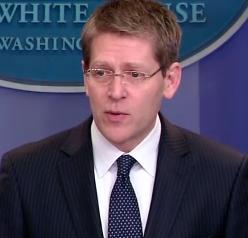
Jay Carney
Jay Carney is the current White House Press Secretary.
History of the Executive Office of the President
In 1939, during Franklin D. Roosevelt’s second term in office, the foundations of the modern White House staff were created. Based on the recommendations of a presidentially commissioned panel of political science and public administration experts, the Brownlow Committee, Roosevelt was able to get Congress to approve the Reorganization Act of 1939. The Act led to Reorganization Plan No. 1, which created the EOP, which reported directly to the president. The EOP encompassed two subunits at its outset: the White House Office (WHO) and the Bureau of the Budget, the predecessor to today’s Office of Management and Budget (OMB), which had been created in 1921 and originally located in the Treasury Department. It absorbed most of the functions of the National Emergency Council. The main job of the OMB is to assist the President to prepare the budget. The OMB also measures the quality of agency programs, policies, and procedures and to see if they comply with the President’s policies. In addition, the OMB oversees and coordinates the Administration’s procurement, financial management, information, and regulatory policies. In each of these areas, the OMB’s role is to help improve administrative management, to develop better performance measures and coordinating mechanisms, and to reduce any unnecessary burdens on the public.
From 1939 through the present, the situation changed dramatically. New units within the EOP were created, some by statute, some by executive order of the president. Among the most important are the Council of Economic Advisers (1946), the National Security Council and its staff (1947), the Office of the U.S. Trade Representative (1963), the Council on Environmental Quality (1970), the Office of Science and Technology Policy (1976), the Office of Administration (1977), and the Office of National Drug Control Policy (1989).
Under George W. Bush, additional units were added, such as the Office of Homeland Security (2001), which later became a cabinet department, and the Office of Faith-based and Community Initiatives (2001). Precise estimates as to the size and budget of the EOP are difficult to come by. Many people who work on the staff are “detailed” from other federal departments and agencies, and budgetary expenses are often charged elsewhere, for example Defense Department staff for the White House Military Office. Ballpark estimates indicate some 2,000 to 2,500 persons serve in EOP staff positions with policy-making responsibilities, with a budget of 300 to 400 million dollars.
12.2.2: The Cabinet
The Cabinet of the United States is composed of the most senior appointed officers of the executive branch of the federal government.
Learning Objective
Discuss the shape of the Cabinet of the United States and its role in government
Key Points
- All Cabinet members are nominated by the President and then presented to the Senate for confirmation or rejection by a simple majority. If they are approved, they are sworn in and then begin their duties.
- There is no explicit definition of the term “Cabinet” in either the U.S. Constitution, the United States Code, or the Code of Federal Regulations.
- Executive Schedule refers to the highest-ranked appointed positions in the executive branch of the U.S. government. The President of the United States, an elected official, appoints incumbents to these positions, most of them with the advice and consent of the Senate.
Key Terms
- Cabinet
-
In parliamentary and some other systems of government, the group of ministers responsible for creating government policy and for overseeing the departments comprising the executive branch.
- executive schedule
-
Executive Schedule refers to the highest-ranked appointed positions in the executive branch of the U.S. government. The President of the United States makes appointments to these positions, most with the advice and consent of the Senate.
Example
- The Secretary of State designate is reviewed and presented to the full Senate by the Senate Foreign Relations Committee. Hillary Rodham Clinton assumed the office of Secretary of State on January 21, 2009.
Introduction
The Cabinet of the United States is composed of the most senior appointed officers of the executive branch of the federal government of the United States, who are generally the heads of the federal executive departments. The existence of the Cabinet dates back to the first President of the United States, George Washington, who appointed a Cabinet of four men: Secretary of State Thomas Jefferson, Secretary of the Treasury Alexander Hamilton, Secretary of War Henry Knox, and Attorney General Edmund Randolph to advise him and to assist him in carrying out his duties.
All Cabinet members are nominated by the President and then presented to the Senate for confirmation or rejection by a simple majority. If they are approved, they are sworn in and begin their duties. Aside from the Attorney General and the Postmaster General (when it was a Cabinet position), they all receive the title of Secretary. Members of the Cabinet serve at the pleasure of the President, which means that the President may dismiss them or reappoint them (to other posts) at will. Members of the Cabinet direct their own departments; however, all of the power that they have derives from the President, in that while they may advise the President, they carry the President’s directives. In other words, the Cabinet may help shape policy, but they do not typically drive or direct policy.
In Federal Law and the Constitution
There is no explicit definition of the term “Cabinet” in either the U.S. Constitution, the United States Code, or the Code of Federal Regulations. There are occasional references to “cabinet-level officers” or “secretaries,” which when viewed in their context do refer to the “Heads of the Executive Departments.” Executive Schedule refers to the highest-ranked appointed positions in the executive branch of the U.S. government. The President of the United States, an elected official, appoints incumbents to these positions, most of them with the advice and consent of the Senate. They include members of the President’s Cabinet as well as other subcabinet policy makers. There are five pay rates within the Executive Schedule, usually denoted with a Roman numeral with I being the highest level and V the lowest.
The President of the United States has the authority to nominate members of his or her cabinet to the United States Senate for confirmation under Article II, Section II, Clause II of the United States Constitution.
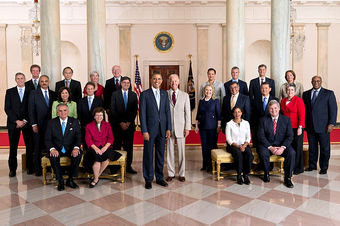
U.S. Cabinet
President Barack Obama and Vice President Joe Biden pose with the full Cabinet for an official group photo in the Grand Foyer of the White House, July 26, 2012. These included U.S. Permanent Representative to the United Nations Susan Rice, Attorney General Eric H. Holder, Jr., Secretary of State Hillary Rodham Clinton, Defense Secretary Leon Panetta, Homeland Security Secretary Janet Napolitano, Health and Human Services Secretary Kathleen Sebelius.
Cabinet Positions
The Secretary of State designate is reviewed and presented to the full Senate by the Senate Foreign Relations Committee. John Kerry is the current Secretary of State for President Obama’s second term, replacing Hillary Clinton. The Secretary of the Treasury is reviewed by the Senate Finance Committee. Jack Lew is Secretary of the Treasury. Ashton Carter is Secretary of Defense.
The confirmation of the office of Attorney General is overseen by the Senate Judiciary Committee. Eric Holder, Obama’s first-term Attorney General was replaced by Loretta E. Lynch for the second term.
12.2.3: The Vice Presidency
Constitutionally, the Vice President is indirectly elected by the people through the Electoral College to a four-year term of office.
Learning Objective
Distinguish between the Vice President’s constitutionally defined functions and the role the office has come to play
Key Points
- The Vice President is the first person in the presidential line of succession, and would ascend to the Presidency upon the death, resignation, or removal of the President.
- While the Vice President’s only constitutionally prescribed functions aside from Presidential succession relate to his role as President of the Senate, the office is commonly viewed as a component of the executive branch of the federal government.
- Under the Constitution, the Vice President is President of the United States Senate. In that capacity, he or she is allowed to vote in the Senate when necessary to break a tie.
- While Senate customs have created supermajority rules that have diminished this Constitutional power, the Vice President still retains the ability to influence legislation.
- In modern times, the Vice President rarely presides over day-to-day matters in the Senate; in his place, the Senate chooses a President pro tempore (or “president for a time”) to preside in the Vice President’s absence; the Senate normally selects the longest-serving senator in the majority party.
- The Twenty-Fifth Amendment of the U.S. Constitution provides that should the president die or become disabled while in office, the “powers and duties” of the office are transferred to the Vice President.
Key Terms
- vice president
-
A deputy to a president, often empowered to assume the position of president on his death or absence
- twenty-fifth amendment
-
The Twenty-fifth Amendment (Amendment XXV) to the United States Constitution deals with succession to the Presidency and establishes procedures both for filling a vacancy in the office of the Vice President, as well as responding to Presidential disabilities.
- president pro tempore
-
The President pro tempore is the second-highest-ranking official of the United States Senate. The United States Constitution states that the Vice President of the United States is the President of the Senate, despite not being a member of the body, and that the Senate must choose a president pro tempore. By a long-standing tradition which has been observed consistently since the 81st Congress, the president pro tempore is the most senior senator in the majority party.
Example
- As President of the Senate, the Vice President has two primary duties: to cast a vote in the event of a Senate deadlock and to preside over and certify the official vote count of the U.S. Electoral College. For example, in the first half of 2001, the Senators were divided 50-50 between Republicans and Democrats and Dick Cheney’s tie-breaking vote gave the Republicans the Senate majority.
Introduction
The Vice President of the United States holds a public office created by the United States Constitution. The vice president, together with the president of the United States, is indirectly elected by the people through the Electoral College to a four-year term of office. The vice president is the first person in the presidential line of succession, and would ascend to the presidency upon the death, resignation, or removal of the president. While the vice president’s only constitutionally prescribed functions, aside from presidential succession, relate to his role as President of the Senate, the office is commonly viewed as a component of the executive branch of the federal government. The current vice president is former U.S. Senator Joseph Biden.
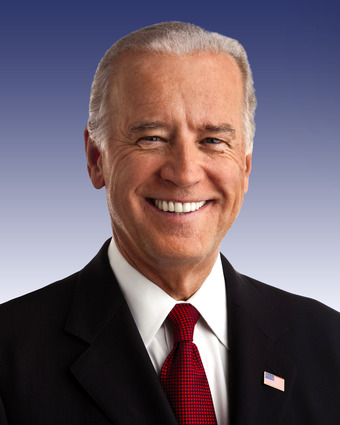
Official Portrait of Joe Biden
Official portrait of Vice President of the United States Joe Biden.
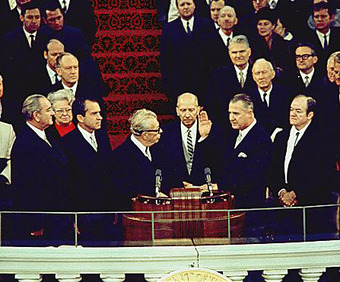
Four Vice-Presidents
Four Vice Presidents: L-R, outgoing Pres. Lyndon B. Johnson (the 37th vice president); incoming Pres. Richard Nixon (36th); Everett Dirksen; Spiro Agnew, incoming vice president (39th); and the outgoing Vice President Hubert Humphrey (38th), January 20, 1969.
Under the Constitution, the vice president is President of the United States Senate. In that capacity, he or she is allowed to vote in the Senate, when necessary, to break a tie. While Senate customs have created supermajority rules that have diminished this constitutional power, the vice president still influences legislation. According to the Twelfth Amendment, the vice president presides over the joint session of Congress when it convenes to count the vote of the Electoral College.
Origin
The creation of the Office of Vice President was a direct consequence of the Electoral College. Delegates to the Philadelphia Convention gave each state a number of presidential electors equal to that state’s combined share of House and Senate seats. Yet, the delegates were worried that each elector would only favor his own state’s favorite son candidate, resulting in deadlocked elections that would produce no winners. To counter this presumed difficulty, the delegates gave each presidential elector two votes, required that at least one of those votes be for a candidate from outside the elector’s state, and mandated that the winner of the election obtain an absolute majority with respect to the total number of electors.
With these rules in place, the delegates hoped each electors’ second vote would go to a statesman of national character However, fearing electors might throw away their second vote to bolster their favorite son’s chance of winning, the Philadelphia delegates specified that the runner up in the election would become vice president. Creating this new office imposed a political cost on discarded votes and, thus, required that electors cast their second ballots.
Roles of the Vice-President
As President of the Senate, the vice president has two primary duties: to cast a vote in the event of a Senate deadlock and to preside over and certify the official vote count of the U.S. Electoral College. For example, in the first half of 2001, the Senators were divided 50-50 between Republicans and Democrats and Dick Cheney’s tie-breaking vote gave the Republicans the Senate majority. In modern times, the vice president rarely presides over day-to-day matters in the Senate; in his place, the Senate chooses a president pro tempore (or “president for a time”) to preside in the vice president’s absence; the Senate normally selects the longest-serving senator in the majority party. The president pro tempore has the power to appoint any other senator to preside and, in practice, junior senators from the majority party are assigned the task of presiding over the Senate most of the time.
The President of the Senate also presides over counting and presentation of the votes of the Electoral College. This process occurs in the presence of both houses of Congress, generally on January 6 of the year following a U.S. presidential election. In this capacity, only four vice presidents have been able to announce their own election to the presidency: John Adams, Thomas Jefferson, Martin Van Buren, and George H. W. Bush. By contrast, Richard Nixon presided over the process but also officially announced the election of his 1960 opponent, John F. Kennedy.
Twenty-Fifth Amendment
The U.S. Constitution provides that should the president die or become disabled while in office, the “powers and duties” of the office are transferred to the vice president. Initially, it was unclear whether the vice president actually became the new president or merely an acting president. This was first tested in 1841 with the death of President William Henry Harrison. Harrison’s Vice President, John Tyler, asserted that he had succeeded to the full presidential office, powers, and title and declined to acknowledge documents referring to him as “acting president. ” Despite some strong calls against it, Tyler took the oath of office as the tenth president. Gerald Ford was the first vice president selected by this method, after the resignation of Vice President Spiro Agnew in 1973; after succeeding to the Presidency, Ford nominated Nelson Rockefeller as vice president.
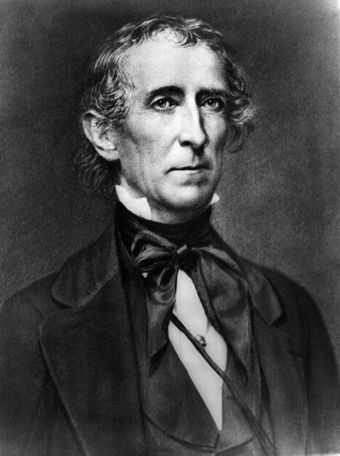
John Tyler
John Tyler was the first Vice President to assume the presidency following the death of his predecessor. In doing so, he insisted that he was the president, not merely an acting president.
12.2.4: The First Spouse
The First Lady of the United States is the hostess of the White House, traditionally filled by the wife of the president.
Learning Objective
Describe the evolution of the role of the First Lady
Key Points
- The use of the title First Lady to describe the spouse or hostess of an executive began in the United States. In the early days of the United States, there was not a generally accepted title for the wife of the president.
- The role of the First Lady has evolved over the centuries. She is, first and foremost, the hostess of the White House. She organizes and attends official ceremonies and functions of state either along with, or in place of, the president.
- The Office of the First Lady of the United States helps the First Lady carry out her duties as hostess of the White House, and is also in charge of all social and ceremonial events of the White House.
- The current First Lady is Michelle Obama, wife of President Barack Obama.
Key Term
- first lady of the united states
-
The First Lady of the United States is the hostess of the White House. Because this position is traditionally filled by the wife of the president of the United States, the title is most often applied to the wife of a sitting president.
Example
- Over the course of the 20th century it became increasingly common for first ladies to select specific causes to promote, usually ones that are not politically divisive. Lady Bird Johnson pioneered environmental protection and beautification; Pat Nixon encouraged volunteerism and traveled extensively abroad; Betty Ford supported women’s rights; Rosalynn Carter aided those with mental disabilities; Nancy Reagan founded the Just Say No drug awareness campaign; Barbara Bush promoted literacy; Hillary Rodham Clinton sought to reform the healthcare system in the U.S.; and Laura Bush supported women’s rights groups and encouraged childhood literacy. Michelle Obama has sought to tackle childhood obesity.
Introduction
The First Lady of the United States is the hostess of the White House. This position is traditionally filled by the wife of the President of the United States. The current First Lady is Michelle Obama , wife of President Barack Obama. At present, there are four living former first ladies: Rosalynn Carter, wife of Jimmy Carter; Barbara Bush, wife of George H. W. Bush; Hillary Rodham Clinton, wife of Bill Clinton; and Laura Bush, wife of George W. Bush .
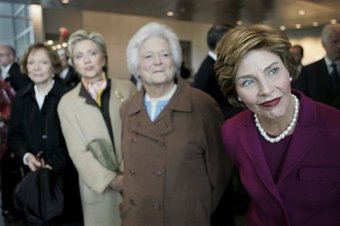
Four First Ladies
Laura Bush and former first ladies, from left, Rosalynn Carter, then-Senator Hillary Clinton, and Barbara Bush, at the dedication ceremony for the William J. Clinton Presidential Center and Park in Little Rock, Arkansas, November 18, 2004.
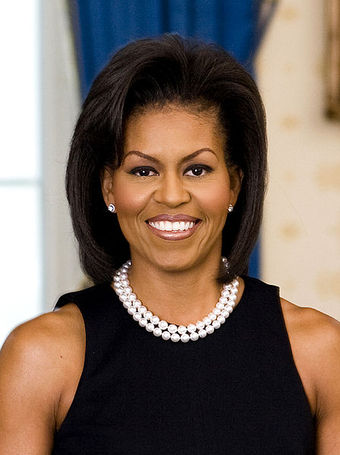
Michelle Obama
Michelle Obama, official White House portrait.
Origins of First Lady
The use of the title First Ladyto describe the spouse or hostess of an executive began in the United States. In the early days of the United States, there was not a generally accepted title for the wife of the president.
The earliest known written evidence of the title is from the November 3, 1863, diary entry of William Howard Russell, in which he recalled gossip about “the First Lady in the Land,” referring to Mary Todd Lincoln. The title first gained nationwide recognition in 1877, when newspaper journalist Mary C. Ames referred to Lucy Webb Hayes as “the First Lady of the Land” while reporting on the inauguration of Rutherford B. Hayes. The frequent reporting on the activities of Lucy Hayes helped spread use of the title outside Washington. A popular 1911 comedic play by playwright Charles Nirdlinger, titled The First Lady in the Land, popularized the title further. By the 1930s it was in wide use. Use of the title later spread from the United States to other nations.
Roles of First Lady
The position of the First Lady is not an elected one, carries no official duties, and receives no salary. Nonetheless, first ladies have held a highly visible position in U.S. government. The role of the First Lady has evolved over the centuries. She is, first and foremost, the hostess of the White House. She organizes and attends official ceremonies and functions of state either along with, or in place of, the president.
Over the course of the 20th century it became increasingly common for first ladies to select specific causes to promote, usually ones that are not politically divisive . It is common for the First Lady to hire a staff to support these activities. Lady Bird Johnson pioneered environmental protection and beautification; Pat Nixon encouraged volunteerism and traveled extensively abroad; Betty Ford supported women’s rights; Rosalynn Carter aided those with mental disabilities; Nancy Reagan founded the Just Say No drug awareness campaign; Barbara Bush promoted literacy; Hillary Rodham Clinton sought to reform the healthcare system in the U.S.; and Laura Bush supported women’s rights groups and encouraged childhood literacy. Michelle Obama has sought to tackle childhood obesity.
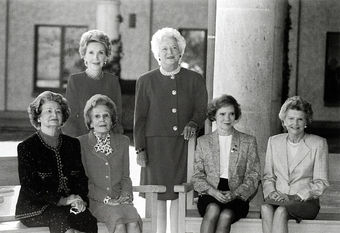
First Ladies at Ronald Reagan Presidential Library
First Ladies Nancy Reagan, Barbara Bush (standing, left to right), Lady Bird Johnson, Pat Nixon, Rosalynn Carter, and Betty Ford (seated, left to right) at the dedication of the Ronald Reagan Presidential Library, November 1991.
Office of the First Lady
The Office of the First Lady of the United States helps the First Lady carry out her duties as hostess of the White House, and is also in charge of all social and ceremonial events of the White House. The First Lady has her own staff that includes the White House Social Secretary, a chief of staff, a press secretary, a chief floral designer, and an executive chef. The Office of the First Lady is an entity of the White House Office, which is part of the Executive Office of the President.
12.3: The President’s Many Roles
12.3.1: Chief Executive
Chief Executive is a term commonly used to refer to Presidential powers given by the Constitution.
Learning Objective
Identify the nature of the powers granted to the President in Article II of the Constitution
Key Points
- The president has many official and unofficial roles. The formal powers and duties of the president are outlined in Article II of the Constitution.
- As Chief Executive the president can: implement policy, supervise the executive branch of government, prepare executive budget for submission to congress, and appoint and remove executive officials.
- The head of government is the chief officer of the executive branch of a government, often presiding over a cabinet. In presidential republics or absolute monarchies, the head of government may be the same person as the head of state, who is often also called a president or a monarch.
Key Terms
- head of government
-
The chief officer of the executive branch of a government, often presiding over a cabinet; usually called Prime Minister (in a parliamentary system) or President (in a presidential system).
- chief executive
-
The president of the United States.
Introduction
The president has many official and unofficial roles. The formal powers and duties of the president are outlined in Article II of the Constitution. Although the Constitution grants far fewer explicit powers to the president in Article II than it does to Congress in Article I, the ambiguity and vagueness of Article II have made it possible for presidents to expand their authority greatly beyond that specifically listed in the Constitution. The two passages in the Constitution that have provided the basis for the expansion of presidential authority are Article II, Section 1, which grants “the executive Power” to the president, and Section 3, which makes the president responsible for the enforcement of federal laws: “He shall take Care that the Laws be faithfully executed.” As a result, “unofficial” presidential roles have evolved through both history and tradition.
As Chief Executive
Chief Executive is a term used for certain gubernatorial offices, expressing the nature of their job being analogous to a head of government. It is commonly used to refer to Presidential powers given by the constitution. As Chief Executive the president can: implement policy, supervise the executive branch of government, prepare an executive budget for submission to congress, and appoint and remove executive officials .
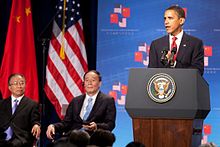
Obama Administration and Foreign Policy
President Barack Obama acts as the chief executive of the federal government of the United States.
As Head of Government
Head of government is the chief officer of the executive branch of a government, often presiding over a cabinet. In a parliamentary system, the head of government is often styled prime minister, chief minister, premier, etc. In presidential republics or absolute monarchies, the head of government may be the same person as the head of state, who is often also called a president or a monarch.
In a parliamentary system, the head of state is normally a different person from the head of government. This is in contrast to a presidential system in a democracy, where the head of state often is also the head of government, and most importantly: the executive branch does not derive its democratic legitimacy from the legislature. The Parliamentary system can be contrasted with a presidential system which operates under a stricter separation of powers, whereby the executive does not form part of, nor is appointed by, the parliamentary or legislative body. In such a system, congresses do not select or dismiss heads of governments, and governments cannot request an early dissolution as may be the case for parliaments. Since the legislative branch has more power over the executive branch in a parliamentary system, a notable amount of studies by political scientists have shown that parliamentary systems show lower levels of corruption than presidential systems of government.
12.3.2: Commander-in-Chief
A commander-in-chief is the person exercising supreme command authority of a nation’s military forces; in the US, this person is the president.
Learning Objective
Explain the President’s position as commander-in-chief
Key Points
- Civilian control of the military is a doctrine in military and political science that places ultimate responsibility for a country’s strategic decision-making in the hands of the civilian political leadership, rather than professional military officers.
- The current commander-in-chief of the United States Armed Forces is Barack Obama, the 44th person to hold the position since Grover Cleveland served two non- consecutive terms as President of the United States.
- Since 1949, the Secretary of Defense, a civil officer appointed by the President with the advice and consent of the Senate, is by statute second in command over those armed forces which are part of the Department of Defense: the Army, Navy, Air Force, and the Marine Corps.
- The Chairman of the Joint Chiefs of Staff, the U.S. chief of defense equivalent, may assist the President and Secretary of Defense in the exercise of their command functions, but the Chairman himself does not independently exercise command over any combatant forces.
Key Terms
- commander-in-chief
-
A commander-in-chief is the person exercising supreme command authority over a nation’s military forces or significant element of those forces.
- civilian control of the military
-
Civilian control of the military is a doctrine in military and political science that places ultimate responsibility for a country’s strategic decision-making in the hands of the civilian political leadership, rather than professional military officers.
- chairman of the joint chiefs of staff
-
The Chairman of the Joint Chiefs of Staff, the U.S. chief of defense equivalent, may assist the President and Secretary of Defense in the exercise of their command functions, but the Chairman himself does not independently exercise command over any combatant forces.
Introduction
A commander-in-chief is the person exercising supreme command authority of a nation’s military forces or significant element of those forces. As a practical term it refers to the military competencies that reside in a nation-state’s executive, Head of State and/or Head of Government. Often, a given country’s commander-in-chief need not be or have been a commissioned officer or even a veteran, and it is by this legal statute that civilian control of the military is realized in states where it is constitutionally required. Civilian control of the military is a doctrine in military and political science that places ultimate responsibility for a country’s strategic decision-making in the hands of the civilian political leadership, rather than professional military officers.
According to Article II, Section 2, Clause I of the Constitution, the President of the United States is commander-in-chief of the United States Armed Forces. The current commander-in-chief of the United States Armed Forces is Barack Obama, the 44th person to hold the position since Grover Cleveland served two non consecutive terms as President of the United States.
U.S. President as Commander in Chief
The amount of military detail handled by the President in wartime has varied dramatically. Abraham Lincoln was deeply involved in overall strategy and in day-to-day operations during the American Civil War, 1861–1865; historians have given Lincoln high praise for his strategic sense and his ability to select and encourage commanders such as Ulysses S. Grant.
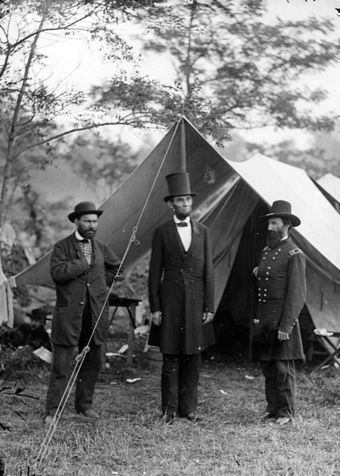
President Abraham Lincoln as Commander-in-Chief
President Abraham Lincoln, as commander-in-chief of the United States Armed Forces, with Allan Pinkerton and Major General John A. McClernand after the Battle of Antietam, 1862.
On the other hand, Woodrow Wilson paid very little attention to operational military details of World War I and had very little contact with General John J. Pershing, who commanded the armies in the field. As President throughout much of World War II, Franklin D. Roosevelt, on the domestic front, used his fireside chats and the press to explain and justify his difficult wartime decisions abroad. Harry S. Truman believed in a high amount of civilian leadership of the military, making many tactical and policy decisions based on the recommendations of his advisors— including the decision to use nuclear weapons on Japan, to commit American forces in the Korean War, and to terminate Douglas MacArthur from his command.
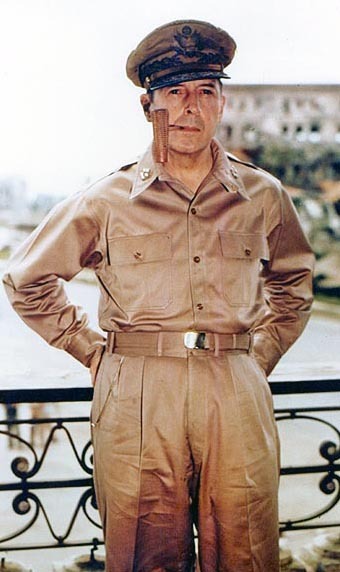
Douglas MacArthur in Manila
An immensely popular hero of World War II, General Douglas MacArthur’s public insistence on the need to expand the Korean War, over the objections of President Harry S. Truman, led to the termination of his command.
Secretary of Defense
Since 1949, the Secretary of Defense, a civil officer appointed by the President with the advice and consent of the Senate, is by statute second in command over those armed forces which are part of the Department of Defense: the Army, Navy, Air Force, and the Marine Corps. The operational branch of the chain of command runs from the President to the Secretary of Defense, and from the Secretary of Defense down to the combatant commanders of the unified combatant commands. The Chairman of the Joint Chiefs of Staff, the U.S. chief of defense equivalent, may assist the President and Secretary of Defense in the exercise of their command functions, but the Chairman himself does not independently exercise command over any combatant forces.
12.3.3: Head of State
The President of the United States of America is the head of state and head of government of the United States.
Learning Objective
Summarize the various roles performed by the President as Head of State
Key Points
- Head of State is a term used in constitutional law, international law, political science, and diplomatic protocol to designate an official who holds the highest ranked position in a state. This official has the vested or implied powers to act as the chief public representative of a sovereign state.
- A presidential system is a system of government where an executive branch is led by a president who serves as both head of state and head of government. In such a system, this branch exists separately from the legislature, to which it is not responsible and which it cannot dismiss.
- In presidential systems, such as that of the United States, appointments are nominated at the President’s sole discretion, but this nomination is often subject to parliamentary confirmation.
- In presidential systems the head of state often formally reports to the legislature on the present national status, as in the State of the Union address in the United States of America.
Key Terms
- head of state
-
The chief public representative of a nation having duties, privileges and responsibilities varying greatly depending on the constitutional rules; a monarch in a monarchy, and often styled president in a republic, but variations such as collegiality exist.
- presidential system
-
A presidential system is a system of government where an executive branch is led by a president who serves as both head of state and head of government. In such a system, this branch exists separately from the legislature, to which it is not responsible and which it cannot, in normal circumstances, dismiss.
Example
- As head of state, the president can fulfill traditions established by previous presidents. William Howard Taft started the tradition of throwing out the ceremonial first pitch in 1910 at Griffith Stadium, Washington, D.C., on the Washington Senators’ Opening Day. Every president since Taft, except for Jimmy Carter, threw out at least one ceremonial first ball or pitch for Opening Day, the All-Star Game, or the World Series, usually with much fanfare.
Introduction
The President of the United States of America is the head of state and head of government of the United States. The president leads the executive branch of the federal government and is the commander-in-chief of the United States Armed Forces. Head of State is a term used in constitutional law, international law, political science, and diplomatic protocol to designate an official who holds the highest ranked position in a state and has the vested or implied powers to act as the chief public representative of a sovereign state. Heads of state in most countries are natural persons holding an office, however in some countries the head of state position is held by a body of persons .
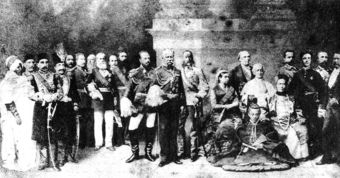
World Head of States 1889
“The World’s Sovereigns”: A photo montage made in Europe in 1889 with the main heads of state in the world. As head of state, it is the job of each of these leaders to represent their countries.
A presidential system is a system of government where an executive branch is led by a president who serves as both head of state and head of government . In such a system, this branch exists separately from the legislature, to which it is not responsible and which it cannot, in normal circumstances, dismiss. Presidential systems are a notable feature of constitutions in the Americas, including those of the Argentina, Brazil, Colombia, El Salvador, Mexico and Venezuela; this is generally attributed to the strong influence of the United States in the region, and as the United States Constitution served as an inspiration and model for the Latin American wars of independence of the early 19th century.
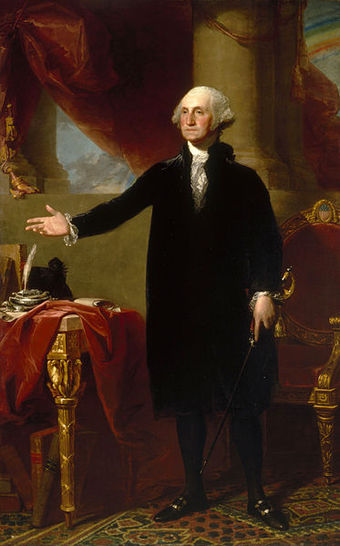
George Washington
George Washington, the first President of the United States, set the precedent for an executive head of state in republican systems of government.
Presidential governments make no distinction between the positions of head of state and head of government, both of which are held by the president. Many parliamentary governments have a symbolic head of state in the form of a president or monarch. That person is responsible for the formalities of state functions, or in cases where the head of state has reserve powers, the “hands off” ensuing of a functional parliament, while the constitutional prerogatives of head of government are generally exercised by the prime minister.
Head of State in the United States
In the 1870s, in the aftermath of the impeachment of President Andrew Johnson and his near-removal from office, it was speculated that the United States, too, would move from a presidential system to a semi-presidential or even parliamentary one. Under this new system, the Speaker of the House of Representatives would become the real center of government as a quasi-prime minister. This did not in fact happen. The presidency, having been damaged by three late nineteenth and early twentieth century assassinations, and one impeachment, reasserted its political dominance by the early twentieth century through such figures as Theodore Roosevelt and Woodrow Wilson.
In presidential systems, such as that of the United States, appointments are nominated by the President’s sole discretion, but this nomination is often subject to parliamentary confirmation (in the case of the US, the Senate has to approve cabinet nominees and judicial appointments by simple majority). Moreover, in presidential systems, the president often has the power to fire ministers at his sole discretion. In the United States, convention calls for cabinet secretaries to resign on their own initiative when called to do so.
Legislative Roles
It is usual that the head of state, particularly in parliamentary systems as part of the symbolic role, is the one who opens the annual sessions of the legislature, e.g. the annual State Opening of Parliament with the Speech from the Throne in Britain. Even in presidential systems the head of state often formally reports to the legislature on the present national status, e.g. the State of the Union address in the United States of America.
Ceremonial Roles
As head of state, the president can fulfill traditions established by previous presidents. William Howard Taft started the tradition of throwing out the ceremonial first pitch in 1910 at Griffith Stadium, Washington, D.C., on the Washington Senators’ Opening Day. Every president since Taft, except for Jimmy Carter, threw out at least one ceremonial first ball or pitch for Opening Day, the All-Star Game, or the World Series, usually with much fanfare .
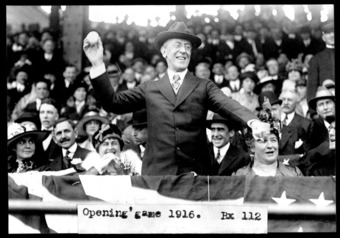
Wilson opening day 1916
U.S. President Woodrow Wilson throws out the ball on opening day of baseball season, 1916.
During a state visit by a foreign head of state, the president typically hosts a State Arrival Ceremony held on the South Lawn, a custom begun by John F. Kennedy in 1961. This is followed by a state dinner given by the president which is held in the State Dining Room later in the evening.
12.3.4: Chief Diplomat
The appointment power of the President allows him or her to appoint and receive ambassadors around the world.
Learning Objective
Explain the President’s role as chief diplomat
Key Points
- Diplomacy is the art and practice of conducting negotiations between representatives of groups or states. In an informal or social sense, diplomacy is the employment of tact to gain strategic advantage or to find mutually acceptable solutions to a common challenge.
- The President is the nation’s chief diplomat; they have the power make treaties that are then subject to ratification by the Senate.
- It is generally accepted that they have the President has the power as a result of their constitutional authority to “send and receive ambassadors. ” This is generally known as the “appointment power” of the presidency.
- Along with naming judges, presidents appoint ambassadors and executive officers. If Congress is not in session, presidents can make temporary appointments known as recess appointments without Senate confirmation, good until the end of the next session of Congress.
Key Terms
- recess appointments
-
Along with naming judges, presidents appoint ambassadors and executive officers. These appointments require Senate confirmation. If Congress is not in session, presidents can make temporary appointments known as recess appointments without Senate confirmation, good until the end of the next session of Congress.
- appointment power
-
The appointment power of the presidency refers to the president’s constitutional authority to appoint and receive ambassadors to and from other countries.
- diplomacy
-
The art and practice of conducting international relations by negotiating alliances, treaties, agreements, etc., bilaterally or multilaterally, between states and sometimes international organizations or even between policies with varying statuses, such as those of monarchs and their princely vassals.
Example
- Informal diplomacy has been used for centuries to communicate between powers. Most diplomats work to recruit figures in other nations who might be able to give informal access to a country’s leadership. Such informal diplomacy was practiced by former US Presidents Jimmy Carter and Bill Clinton and by the former Israeli diplomat and minister Yossi Beilin.
Introduction
Diplomacy is the art and practice of conducting negotiations between representatives of groups or states. It usually refers to international diplomacy, the conduct of international relations through the intercession of professional diplomats with regard to issues of peacemaking, trade, war, economics, culture, environment and human rights. International treaties are usually negotiated by diplomats prior to endorsement by national politicians. In an informal or social sense, diplomacy is the employment of tact to gain strategic advantage or to find mutually acceptable solutions to a common challenge, one set of tools being the phrasing of statements in a nonconfrontational, or polite manner.
U.S. President as Chief Diplomat
Although the Constitution does not explicitly grant presidents the power to recognize foreign governments, it is generally accepted that they have this power as a result of their constitutional authority to “send and receive ambassadors. ” This is generally known as the “appointment power” of the presidency. Because the acts of sending an ambassador to a country and receiving its representative imply recognition of the legitimacy of the foreign government involved, presidents have successfully claimed exclusive authority to decide which foreign governments are recognized by the United States. It follows, then, that they have the power to terminate relations with other nations as well.
Along with naming judges, presidents appoint ambassadors and executive officers. These appointments require Senate confirmation. If Congress is not in session, presidents can make temporary appointments known as recess appointments without Senate confirmation, good until the end of the next session of Congress.
Although not constitutionally provided, presidents also sometimes employ “executive agreements” in foreign relations. These agreements frequently regard administrative policy choices germane to executive power; for example, the extent to which either country presents an armed presence in a given area, how each country will enforce copyright treaties, or how each country will process foreign mail. However, the 20th century witnessed a vast expansion of the use of executive agreements, and critics have challenged the extent of that use as supplanting the treaty process and removing constitutionally prescribed checks and balances over the executive in foreign relations. Supporters counter that the agreements offer a pragmatic solution when the need for swift, secret, and/or concerted action arises.
Informal Diplomacy
Informal diplomacy has been used for centuries to communicate between powers. Most diplomats work to recruit figures in other nations who might be able to give informal access to a country’s leadership. On some occasion a former holder of an official position continues to carry out an informal diplomatic activity after retirement. In some cases, governments welcome such activity, for example as a means of establishing an initial contact with a hostile state of group without being formally committed. In other cases, however, such informal diplomats seek to promote a political agenda different from that of the government currently in power. Such informal diplomacy is practiced by former US Presidents Jimmy Carter and (to a lesser extent) Bill Clinton and by the former Israeli diplomat and minister Yossi Beilin.
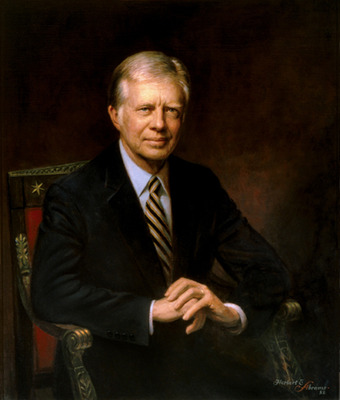
James Carter Presidential Portrait
Jimmy Carter served as the thirty-ninth President of the United States from 1977 to 1981.
12.3.5: Chief Legislator
As chief legislator, the president may suggest, request, and insist that Congress enact laws he believes are needed.
Learning Objective
Assess the significance of the Line Item Veto for executive power
Key Points
- As chief legislator, the president shapes policy. The Constitution is reticent about the president’s role in legislating, yet the relationship between Congress and the executive is the most important aspect of the U.S. system of government.
- The president may suggest, request, and insist that Congress enact laws he believes are needed. He can attempt to influence Congress through promises of patronage and favors.
- In 1996, Congress attempted to enhance the president’s veto power with the Line Item Veto Act. The legislation empowered the president to sign any spending bill into law while simultaneously striking certain spending items within the bill.
- In Clinton v. City of New York (1998), the U.S. Supreme Court ruled such a legislative alteration of the veto power to be unconstitutional.
Key Terms
- line item veto act
-
The Line Item Veto Act of 1996 enacted a line-item veto for the Federal government of the United States, but its effect was brief because the act was overturned after judicial review.
- clinton v. city of new york
-
In Clinton v. City of New York (1998), the U.S. Supreme Court ruled the Line Item Veto Act’s expansion of veto power to be unconstitutional.
- veto
-
A political right to disapprove of (and thereby stop) the process of a decision, a law, etc.
- pocket veto
-
a legislative maneuver in lawmaking that allows a president or other official to unilaterally stop a bill by taking no action
Chief Legislator
The president has many official and unofficial roles. The formal powers and duties of the president are outlined in Article II of the Constitution. As chief legislator, the president shapes policy. The Constitution is reticent about the president’s role in legislating, yet the relationship between Congress and the executive is the most important aspect of the U.S. system of government. The president can gather information from the bureaucracy, present a legislative agenda to Congress, and go to the American public for support for his legislative agenda.
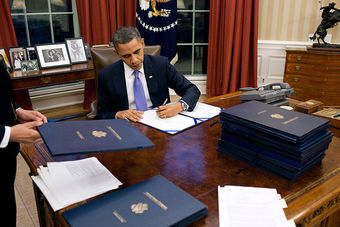
President Barack Obama Signing Legislation
President Barack Obama signs legislation in the Oval Office, Dec. 22, 2010. (Official White House Photo by Pete Souza)
The president may suggest and request that Congress enact laws he believes are needed. He can attempt to influence Congress through promises of patronage and favors. He stays in touch with Congress formally through written messages and informally through private meetings, parties, and phone calls. When the president receives legislation, he decides whether to veto it, use the pocket veto, sign it, or do nothing. If the president does nothing, then if Congress is still in session ten days later it becomes law.
In 1996, Congress attempted to enhance the president’s veto power with the Line Item Veto Act. The legislation empowered the president to sign any spending bill into law while simultaneously striking certain spending items within the bill, particularly any new spending, any amount of discretionary spending, or any new limited tax benefit. Once a president had stricken the item, Congress could pass that particular item again. If the president then vetoed the new legislation, Congress could override the veto by the ordinary method of a two-thirds vote in both houses. In Clinton v. City of New York (1998), the U.S. Supreme Court ruled such a legislative alteration of the veto power to be unconstitutional.
12.3.6: Political Party Leader
The president is largely responsible for dictating the legislative agenda of his political party.
Learning Objective
Describe roles that the President plays above and beyond serving as the nation’s chief executive
Key Points
- The Constitution’s Ineligibility Clause prevents the president from simultaneously being a member of Congress. Therefore, the president cannot directly introduce legislative proposals for consideration in Congress.
- Nevertheless, the president can take an indirect role in shaping legislation, especially if the president’s political party has a majority in one or both houses of Congress.
- The modern presidential campaign begins before the primary elections, which the two major political parties use to clear the field of candidates before their national nominating conventions, where the most successful candidate is made the party’s nominee for president.
Key Term
- ineligibility clause
-
The Constitution’s Ineligibility Clause prevents the president from simultaneously being a member of Congress. Therefore, the president cannot directly introduce legislative proposals for consideration in Congress.
Example
- The president can take an indirect role in shaping legislation, especially if the president’s political party has a majority in one or both houses of Congress. For example, the president or other officials of the executive branch may draft legislation and then ask senators or representatives to introduce these drafts into Congress.
Introduction
The President of the United States of America is the head of state and head of government of the United States. The president leads the executive branch of the federal government and is the commander-in-chief of the United States Armed Forces. Since the founding of the United States, the power of the president and the federal government have grown substantially, and each modern president, despite possessing no formal legislative powers beyond signing or vetoing congressionally passed bills, is largely responsible for dictating the legislative agenda of his party and the foreign and domestic policy of the United States .
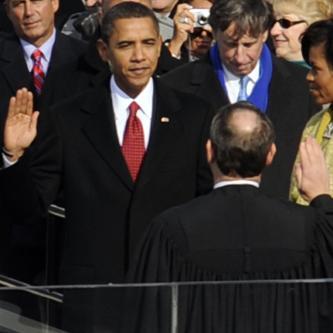
Obama Taking Oath of Office
After winning the 2008 presidential election, Barack Obama was sworn into office on January 20, 2009.
As Legislative Facilitator
The Constitution’s Ineligibility Clause prevents the president from simultaneously being a member of Congress. Therefore, the president cannot directly introduce legislative proposals for consideration in Congress. However, the president can take an indirect role in shaping legislation, especially if the president’s political party has a majority in one or both houses of Congress. For example, the president or other officials of the executive branch may draft legislation and then ask senators or representatives to introduce these drafts into Congress. The president can further influence the legislative branch through constitutionally mandated, periodic reports to Congress. These reports may be either written or oral, but today are given as the State of the Union Address, which often outlines the president’s legislative proposals for the coming year.
Campaigns and Nomination
The modern presidential campaign begins before the primary elections, which the two major political parties use to clear the field of candidates before their national nominating conventions, where the most successful candidate is made the party’s nominee for president. Typically, the party’s presidential candidate chooses a vice presidential nominee, and this choice is rubber stamped by the convention. Nominees participate in nationally televised debates, and while the debates are usually restricted to the Democratic and Republican nominees, third party candidates may be invited, such as Ross Perot in the 1992 debates. Nominees campaign across the country to explain their views, convince voters, and solicit contributions. Much of the modern electoral process is concerned with winning swing states through frequent visits and mass media advertising drives.
